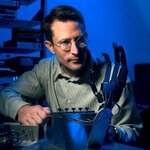Applied Physics

New research at the Weizmann Institute of Science says that the pace of evolution might speed up if the goals themselves change continuously.
Nadav Kashtan, Elad Noor and Prof. Uri Alon of the Institute’s Molecular Cell Biology and Physics of Complex Systems Departments create computer simulations that mimic natural evolution, allowing them to investigate processes that, in nature, take place over millions of years.
In these simulations, a population of digital genomes evolves over time towards a given goal: to maximize fitness under certain conditions. Like living organisms, genomes that…

Between 5 and 10 degrees of cooling was the success criteria for the first milestone in a project involving magnetic cooling at Risø National Laboratory – Technical University of Denmark (DTU) and the first milestone has been achieved.
The figure is currently at 8.7°C; this means that a refrigerator at room temperature (20°C) can be cooled to almost 11°C, not quite enough to keep milk cold, but the project’s test setup is enough to achieve the objective of conducting research in different materials, varying operating conditions and the strength of the magnetic field.
“The setup is not the…

Engineers at Purdue are working on technology that produces hydrogen by adding water to an alloy of aluminum and gallium. When water is added to the alloy, the aluminum splits water by attracting oxygen, liberating hydrogen in the process. The Purdue researchers are developing a method to create particles of the alloy that could be placed in a tank to react with water and produce hydrogen on demand.
The gallium is a critical component because it hinders the formation of an aluminum oxide skin normally created on aluminum's surface after bonding with oxygen, a process called oxidation. This…

Chemical engineers at Purdue believe they have discovered a fundamental flaw in the conventional view of how liquids form bubbles that grow and turn into vapors and that their findings cast into doubt some aspects of a theory dating back to the 1920s, said David S. Corti, an associate professor of chemical engineering at Purdue University.
The research could lead to a more precise understanding of the "phase transition" that takes place when bubbles form, grow and then become a vapor, which could, in turn, have implications for industry and research, Corti said.
In the conventional view, a…

Combine a mechanical arm with a miniature rocket motor: The result is a prosthetic device that is the closest thing yet to a bionic arm.
A prototype of this radical design has been successfully developed and tested by a team of mechanical engineers at Vanderbilt University as part of a $30 million federal program to develop advanced prosthetic devices.
“Our design does not have superhuman strength or capability, but it is closer in terms of function and power to a human arm than any previous prosthetic device that is self-powered and weighs about the same as a natural arm,” says Michael…

A Virginia Tech researcher is working on a device to create biofuels from bird litter - bedding, manure, feathers, spilled feed and everything else on the floor of chicken coops.
Foster Agblevor, associate professor of biological systems engineering, and a team are developing transportable pyrolysis units that will convert the waste into bio-oil by heating the litter until it vaporizes. The vapor is then condensed to produce the bio-oil, and a slow release fertilizer is recovered from the reactor. The gas can then be used to operate the pyrolysis unit, making it a self-sufficient system.…

Kaiping Peng, a friend of mine who is a professor at Berkeley, recently said to me that professors have an unusual place in our society: They are expected to tell the truth. Hardly anyone else is, he said. But what happens when they do?
The most impressive professorial truth-telling in my lifetime has been The Man Who Would Be Queen: The Science of Gender-Bending and Transsexualism (2003) by Michael Bailey, a professor of psychology at Northwestern. It’s mainly about male homosexuals but it also discusses male-to-female transsexuals, not all of whom are homosexual. The “controversy” —…

All bad jokes aside, their research represents a step forward in computers reaching the capability of a human mind.
"This work has a relationship to 'Sociable Computing,'" says Larry Mazlack. "Currently, computers are often difficult to communicate with, to use and to apply to solving problems that are informally stated.
“The ‘robot’ is just a software program that still needs a lot of work,” says researcher Julia Taylor. “The idea is to be able to recognize jokes that are based on phonological similarity of words.”
The program can in fact recognize jokes, but ONLY when the necessary…

Scientists have discovered a new protein that may offer fresh insights into brain function in mad cow disease. “Our team has defined a second prion protein called ‘Shadoo’, that exists in addition to the well-known prion protein called ‘PrP’ ” said Professor David Westaway, director of the Centre for Prions and Protein Folding Diseases at the University of Alberta.
“For decades we believed PrP was a unique nerve protein that folded into an abnormal shape and caused prion disease: end of story. This view is no longer accurate,” Westaway adds.
The study was conducted jointly by the University…

By using pulses of light to dramatically accelerate quantum computers, University of Michigan researchers have made strides in technology that could foil national and personal security threats.
It's a leap, they say, that could lead to tougher protections of information and quicker deciphering of hackers' encryption codes.
A new paper on the results of this research, "Coherent Optical Spectroscopy of a Strongly Driven Quantum Dot," appears in the Aug. 17 issue of Science. Duncan Steel, the Robert J. Hiller Professor at Michigan Engineering's Department of Electrical Engineering and Computer…